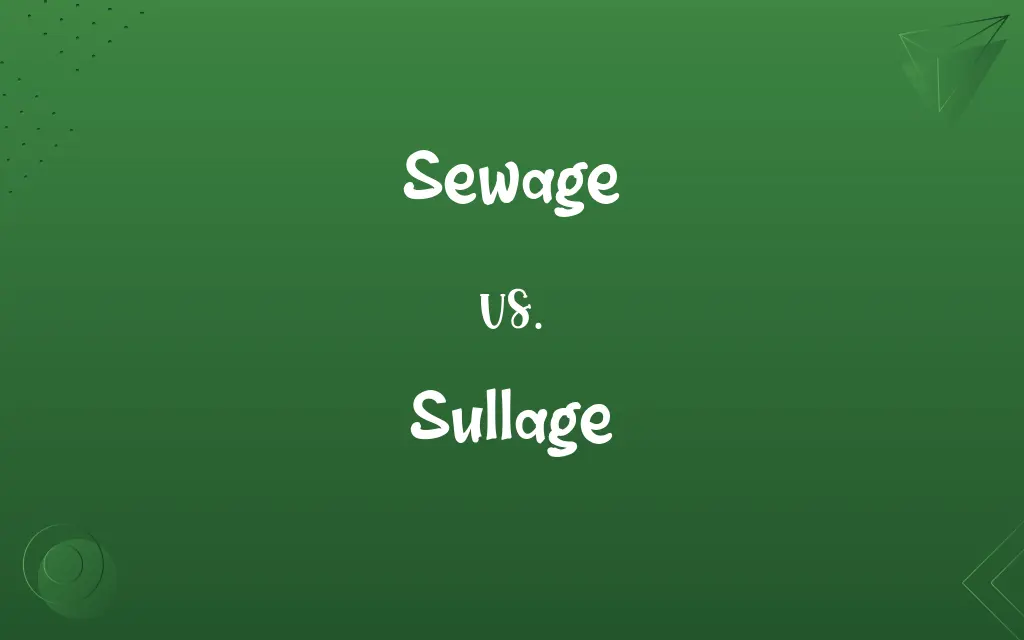Sewage vs. Sullage: Know the Difference

By Shumaila Saeed || Updated on February 23, 2024
Sewage is waste water and solids with human waste from various establishments. Sullage, or greywater, is non-toilet waste water from sinks, showers, and laundry, without fecal matter.

Key Differences
Sewage originates from a broader range of sources including toilets, kitchens, and industrial processes. It contains organic and inorganic matter, nutrients, pathogens, and sometimes hazardous chemicals. Sullage comes specifically from household activities excluding toilet waste. It's characterized by soap particles, grease, and food residues, but typically lacks the pathogens found in sewage.
Shumaila Saeed
Feb 23, 2024
Sewage requires comprehensive treatment processes to remove contaminants and pathogens before it can be safely discharged into the environment or reused. Treatment plants use physical, chemical, and biological methods to treat sewage. Sullage although cleaner than sewage, it still requires treatment or filtration before reuse or disposal. However, the treatment is less complex, focusing on removing non-toxic substances.
Shumaila Saeed
Feb 23, 2024
Sewage poses significant health risks due to the presence of harmful bacteria and viruses. Untreated sewage can contaminate water bodies, affecting aquatic life and human health. Generally Sullage has a lower environmental and health impact compared to sewage. Properly managed sullage can be reused for irrigation and other non-potable purposes, reducing the demand on freshwater resources.
Shumaila Saeed
Feb 23, 2024
After treatment, sewage can be reused for agricultural irrigation, industrial cooling, or replenishing aquifers, contributing to sustainable water management practices. Sullage is easier to recycle and reuse for gardening, flushing toilets, or washing cars, making it a valuable resource in water-scarce areas.
Shumaila Saeed
Feb 23, 2024
Strict regulations regarding its collection, treatment, and disposal to protect public health and the environment. While regulations exist, they are often less stringent than those for sewage. However, increasing awareness about water conservation is leading to more guidelines for sullage reuse.
Shumaila Saeed
Feb 23, 2024
ADVERTISEMENT
Comparison Chart
Source
Toilets, kitchens, industrial processes.
Showers, sinks, laundry, excluding toilets.
Shumaila Saeed
Feb 23, 2024
Composition
Contains human waste, pathogens, chemicals.
Soap particles, grease, food residues, no fecal matter.
Shumaila Saeed
Feb 23, 2024
Treatment Needs
Requires comprehensive treatment to remove pathogens and contaminants.
Requires simpler treatment, mainly for non-toxic substances.
Shumaila Saeed
Feb 23, 2024
Health Risks
High, due to pathogens and potentially hazardous chemicals.
Lower than sewage, mainly due to the absence of fecal contamination.
Shumaila Saeed
Feb 23, 2024
Environmental Impact
Significant if untreated, can contaminate water bodies and harm ecosystems.
Less severe, can be reused for irrigation with minimal treatment.
Shumaila Saeed
Feb 23, 2024
ADVERTISEMENT
Reuse Potential
High, post-treatment; used for agriculture, industrial cooling, aquifer replenishment.
High, with simpler filtration; used for gardening, toilet flushing, car washing.
Shumaila Saeed
Feb 23, 2024
Regulatory Framework
Strict regulations for collection, treatment, and disposal to protect health and environment.
Less stringent than sewage, but growing focus on guidelines for reuse to conserve water.
Shumaila Saeed
Feb 23, 2024
Management Challenges
Complex and costly treatment processes required to safely dispose of or reuse.
Easier to manage and recycle, though still requires appropriate systems for collection and treatment.
Shumaila Saeed
Feb 23, 2024
Sewage and Sullage Definitions
Sewage
Resource recovery.
Advanced sewage treatment plants recover energy and nutrients from waste water.
Shumaila Saeed
Feb 23, 2024
Sullage
Sustainable practice.
Incorporating sullage recycling into building design is a step towards sustainable living.
Shumaila Saeed
Feb 23, 2024
ADVERTISEMENT
Sullage
The liquid discharges from kitchens, washbasins, toilets etc; sewage.
Shumaila Saeed
Oct 19, 2023
Sewage
Treatment necessity.
Sewage must undergo several treatment stages before it can be released into rivers.
Shumaila Saeed
Feb 23, 2024
Sullage
(metallurgy) The scoria on the surface of molten metal in the ladle.
Shumaila Saeed
Oct 19, 2023
Sewage
Environmental hazard.
Untreated sewage can lead to severe water pollution, affecting both aquatic life and human health.
Shumaila Saeed
Feb 23, 2024
Sullage
Simple treatment.
A basic filtration system can make sullage safe for watering plants.
Shumaila Saeed
Feb 23, 2024
Sewage
Contains human waste.
Sewage from residential areas is rich in nutrients but also pathogens that require careful handling.
Shumaila Saeed
Feb 23, 2024
Sewage
Waste water mixture.
The sewage system in the city was upgraded to handle increased waste from the growing population.
Shumaila Saeed
Feb 23, 2024
Sullage
Drainage of filth; filth collected from the street or highway; sewage.
The streets were exceedingly large, well paved, having many vaults and conveyances under them for sullage.
Shumaila Saeed
Oct 19, 2023
Sewage
A suspension of water and solid waste, transported by sewers to be disposed of or processed.
Shumaila Saeed
Oct 19, 2023
Sullage
Non-toilet waste water.
Sullage from the kitchen and bathroom is reused for garden irrigation after simple treatment.
Shumaila Saeed
Feb 23, 2024
Sewage
The contents of a sewer or drain; refuse liquids or matter carried off by sewers
Shumaila Saeed
Oct 19, 2023
Sullage
Lower health risks.
Compared to sewage, sullage poses fewer health risks and is easier to treat.
Shumaila Saeed
Feb 23, 2024
Sullage
That which sullies or defiles.
It is the privilege of the celestial luminaries to receive no tincture, sullage, or difilement from the most noisome sinks and dunghills here below.
Shumaila Saeed
Oct 19, 2023
Sullage
Conservation potential.
Using sullage for flushing toilets significantly reduces household water consumption.
Shumaila Saeed
Feb 23, 2024
Repeatedly Asked Queries
What constitutes sullage or greywater?
Sullage, or greywater, refers to all waste water generated in households or buildings from streams without fecal contamination, such as sinks, showers, and laundry, excluding toilets.
Shumaila Saeed
Feb 23, 2024
Can sullage be reused, and if so, how?
Yes, sullage can be reused for irrigation, flushing toilets, and other non-potable purposes after basic treatment like filtration and disinfection to remove impurities.
Shumaila Saeed
Feb 23, 2024
What are the main health risks associated with untreated sewage?
Untreated sewage can contain pathogens, chemicals, and heavy metals, posing serious health risks such as waterborne diseases, poisoning, and infections.
Shumaila Saeed
Feb 23, 2024
What regulatory standards apply to the treatment and disposal of sewage?
Regulatory standards for sewage treatment and disposal vary by jurisdiction but generally include limits on pollutants, pathogens, and chemical concentrations in discharged water.
Shumaila Saeed
Feb 23, 2024
How is sewage treated?
Sewage treatment involves physical, chemical, and biological processes to remove contaminants, making the water safe for discharge into the environment or for reuse.
Shumaila Saeed
Feb 23, 2024
What is sewage?
Sewage is waste water and solids from residences, institutions, and commercial and industrial establishments, containing human waste, which requires treatment before disposal or reuse.
Shumaila Saeed
Feb 23, 2024
What role do septic tanks play in sewage management?
Septic tanks play a crucial role in on-site sewage management for areas without access to centralized sewage treatment plants, by separating and partially treating solids and liquids.
Shumaila Saeed
Feb 23, 2024
What are the environmental impacts of improperly managed sewage?
Improperly managed sewage can lead to water pollution, harming aquatic ecosystems, contaminating drinking water sources, and contributing to the spread of disease.
Shumaila Saeed
Feb 23, 2024
How can households reduce the amount of sewage they produce?
Households can reduce sewage production by using water-efficient fixtures, repairing leaks, and separating greywater for reuse in landscaping or toilet flushing.
Shumaila Saeed
Feb 23, 2024
Can greywater systems be retrofitted into existing buildings?
Yes, greywater systems can often be retrofitted into existing buildings, though it may require significant plumbing modifications depending on the building's design and intended reuse applications.
Shumaila Saeed
Feb 23, 2024
How does climate change impact sewage and sullage management?
Climate change impacts include increased rainfall leading to sewage overflows, rising temperatures affecting treatment processes, and droughts necessitating the reuse of sullage for water conservation.
Shumaila Saeed
Feb 23, 2024
Why is it important to differentiate between sewage and sullage?
Differentiating between sewage and sullage is important for waste water management, as they require different treatment processes and sullage has greater potential for reuse with less treatment.
Shumaila Saeed
Feb 23, 2024
Are there any innovative technologies in sewage treatment?
Yes, innovative technologies in sewage treatment include membrane bioreactors, advanced oxidation processes, and nutrient recovery systems, improving efficiency and sustainability.
Shumaila Saeed
Feb 23, 2024
What measures can be taken to improve the sustainability of sewage and sullage management?
Measures include investing in advanced treatment technologies, promoting water conservation and greywater reuse, and implementing policies for pollution prevention and resource recovery.
Shumaila Saeed
Feb 23, 2024
What are the challenges of managing sewage in urban areas?
Challenges include aging infrastructure, high treatment costs, pollution control, and accommodating urban growth while ensuring sustainable waste water management.
Shumaila Saeed
Feb 23, 2024
Share this page
Link for your blog / website
HTML
Link to share via messenger
About Author
Written by
Shumaila SaeedShumaila Saeed, an expert content creator with 6 years of experience, specializes in distilling complex topics into easily digestible comparisons, shining a light on the nuances that both inform and educate readers with clarity and accuracy.








































































